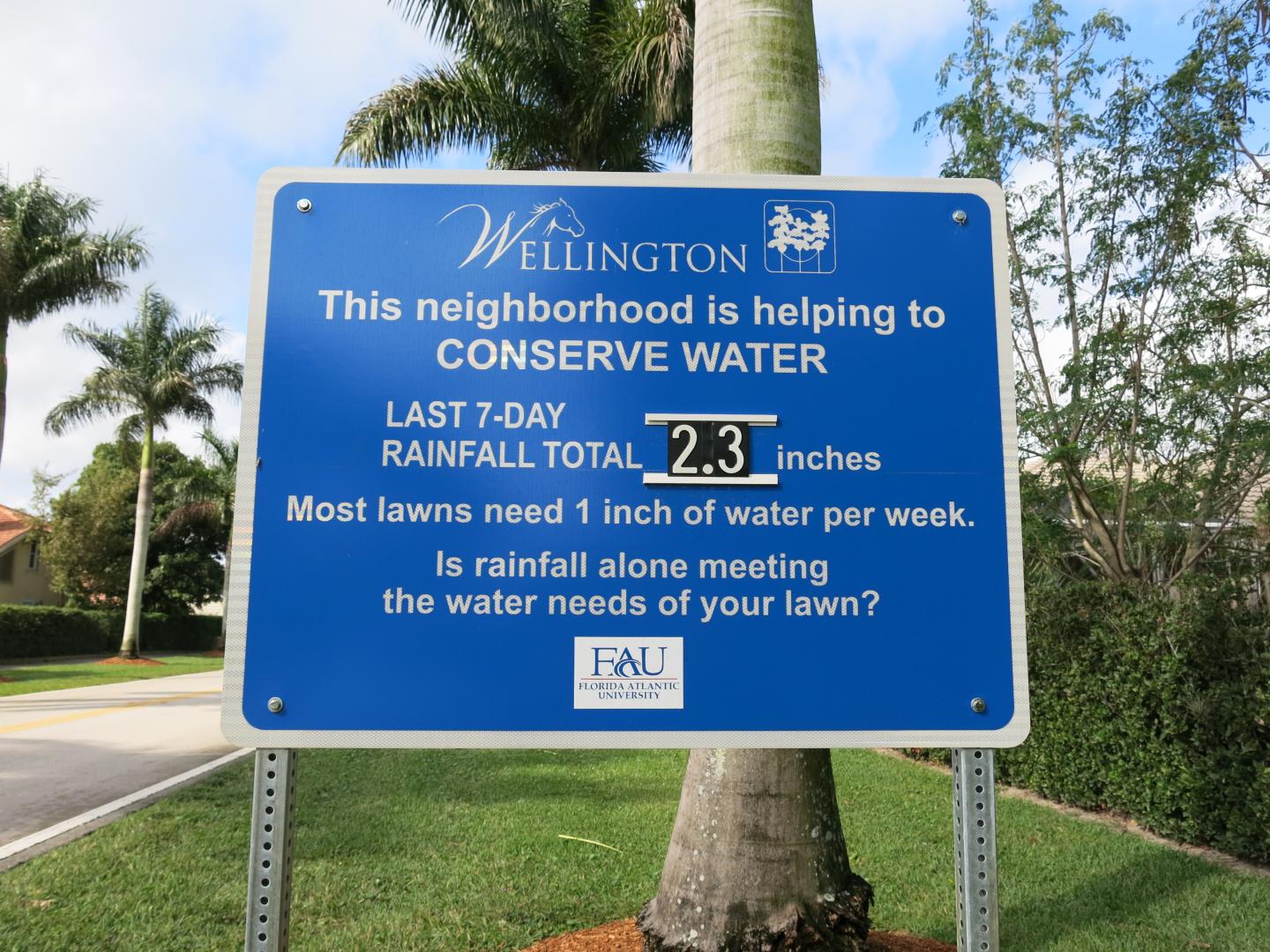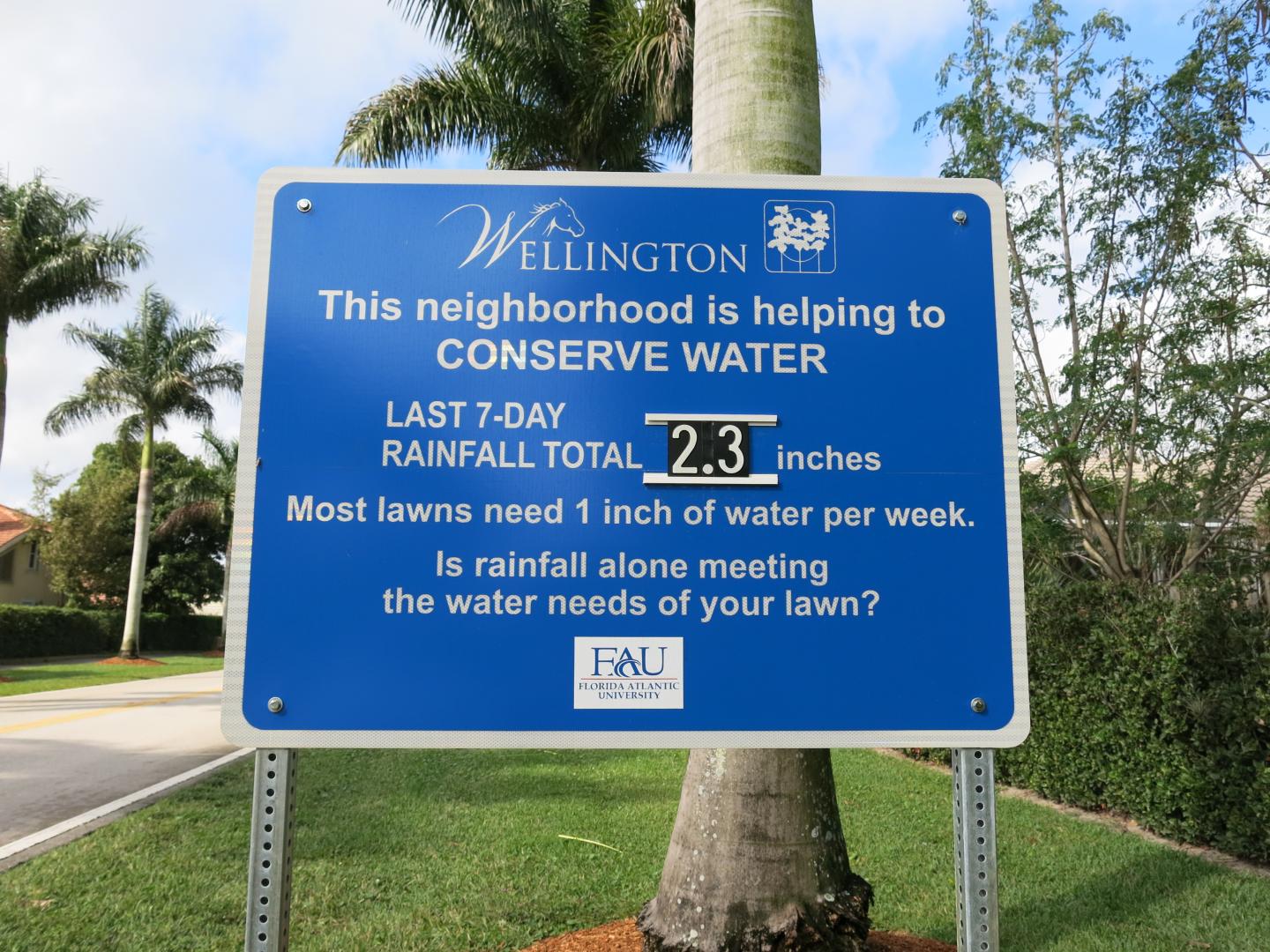
Credit: Florida Atlantic University
Rain or shine has new meaning thanks to an innovative, inexpensive and simple tactic developed by researchers at Florida Atlantic University that will really change how people think about watering their lawns. The tactic? A straightforward road sign.
Outdoor water restrictions are a common water conservation strategy in the United States, Canada, Australia and other countries to address water use as it relates to maintaining lawns and greenspace. In fact, 29 states in the U.S. have outdoor water restrictions that only allow lawn watering on certain days or times. Conserving water is critical because 50 to 90 percent of household water is used for this purpose. Furthermore, to provide each South Florida lawn with the necessary one-inch of water per week, it takes more than 62 gallons of water for every 10-foot-by-10-foot area.
However, this one-pronged approach of water restrictions that involves pre-set and arbitrary lawn-watering schedules does not always result in actual water savings so Tara Root, Ph.D., associate professor in the Department of Geosciences in FAU's Charles E. Schmidt College of Science, and Felicia D. Survis, who recently earned her Ph.D. at FAU, decided to do some research.
For two years, which included two annual wet and dry seasons, they conducted a unique study in Wellington, a suburban village in South Florida, to demonstrate how you can save a lot of water by simply providing people with more information than just directives, schedules or guidelines about which days of the week they can water their lawns. Wellington provided the perfect venue for this study since the village is located in a region that has distinct wet and dry seasons and that is subject to permanent year-round mandatory water restrictions. Additionally, Wellington was interested in the research and helped to implement the pilot program. Results of their study are published in the current issue of the Journal of Environmental Management.
"The Rain-watered Lawn," a pilot program, was implemented as a weather-based add-on water conservation strategy to find out if informing lawn-watering behavior is more effective than just having mandatory water restrictions alone. The study involved a total of 627 households that were divided into two groups: 321 households assigned to an experimental group, and 306 households assigned to a control group who were subject to only the existing water restrictions.
For the study, the researchers created a highly visible road sign that matched existing road signs, and placed them close to the entrances of the experimental neighborhoods. The purpose of the signs was to communicate rainfall levels in the last seven days and to remind people that most South Florida lawns only need one inch of water per week. The bottom of the sign read: "Is rainfall alone meeting the water needs of your lawn?" At the same time that the signs went up, households in the experimental group received a postcard and leaflet about the signs and informed them that existing water restrictions were not being replaced or modified.
"We would significantly benefit from a new approach to outdoor water conservation to improve how we conserve water and to help people better recognize and synchronize with the regional water balance," said Survis. "People realize that there is something more meaningful that they could be doing to conserve water besides just following a watering schedule, but they have no clear idea about what to do."
For the study, the researchers gathered a long-term data set of residential lawn-watering frequency and lawn-watering behaviors, determined the scale of weekly lawn-watering frequency with water restrictions alone, and tested to determine if adding the weather-based conservation strategy could improve lawn irrigation efficiency and water savings over water restrictions alone. They collected rainfall data from a weather station located close to the study area so that the rainfall totals on the signs were as representative as possible of actual conditions.
Results of their research show the greatest impact during the rainier summer weeks with an astounding 61 percent decrease in lawn watering in the experimental households as compared to the control group.
"This was a particularly powerful finding because virtually all lawn watering during those rainier weeks was unnecessary," said Root. Findings also show that once the significant, initial 61 percent drop in lawn watering occurred shortly after the signs went up during the test year, the experimental group maintained a wide separation from the control group, where they stayed at about 41 percent below the control group. Root and Survis speculate that this continued pattern in the experimental group could be habitual because of the conservation behaviors that occurred during the wet weeks that were carried over into the dryer season.
"While this program was especially effective in South Florida, a region with distinct seasonal rainfall, this novel approach developed at Florida Atlantic University is broadly applicable to addressing a global issue in any region to better sync lawn-watering conditions with actual conditions," said Ata Sarajedini, Ph.D., dean of FAU's Charles E. Schmidt College of Science. "This program has the added benefit of getting people more in tune with the natural water cycle, which might help urban and suburban residents prepare for changes in water supply policy that may become necessary as the climate changes."
The researchers stress that because reductions in lawn water use are closely related to reductions in water contamination, a greater sense of environmental stewardship could be tied to everyday activities such as cutting back on unnecessary lawn irrigation.
"With some modifications and use of technology such as texting and the internet, a weather-based outreach project like ours could be scaled up for much larger metropolitan areas," said Root.
###
About Florida Atlantic University:
Florida Atlantic University, established in 1961, officially opened its doors in 1964 as the fifth public university in Florida. Today, the University, with an annual economic impact of $6.3 billion, serves more than 30,000 undergraduate and graduate students at sites throughout its six-county service region in southeast Florida. FAU's world-class teaching and research faculty serves students through 10 colleges: the Dorothy F. Schmidt College of Arts and Letters, the College of Business, the College for Design and Social Inquiry, the College of Education, the College of Engineering and Computer Science, the Graduate College, the Harriet L. Wilkes Honors College, the Charles E. Schmidt College of Medicine, the Christine E. Lynn College of Nursing and the Charles E. Schmidt College of Science. FAU is ranked as a High Research Activity institution by the Carnegie Foundation for the Advancement of Teaching. The University is placing special focus on the rapid development of critical areas that form the basis of its strategic plan: Healthy aging, biotech, coastal and marine issues, neuroscience, regenerative medicine, informatics, lifespan and the environment. These areas provide opportunities for faculty and students to build upon FAU's existing strengths in research and scholarship. For more information, visit http://www.fau.edu.
Media Contact
Gisele Galoustian
[email protected]
561-297-2676
http://www.fau.edu
############
Story Source: Materials provided by Scienmag





